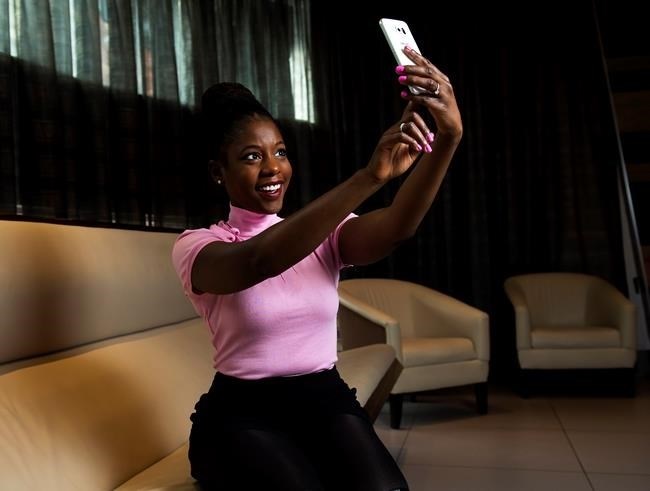
Oneika Raymond, Canadian travel blogger behind the site Oneika the Traveller poses for a photograph in Toronto on Friday, December 16, 2016. Oneika Raymond has spent years documenting her globetrotting adventures online, but the Canadian travel blogger says broadcasting her experiences live has brought a whole new dimension to digital storytelling.
Image Credit: THE CANADIAN PRESS/Nathan Denette
December 26, 2016 - 8:00 PM
TORONTO - Oneika Raymond has spent years documenting her globetrotting adventures online, but the Canadian travel blogger says broadcasting her experiences live has brought a whole new dimension to digital storytelling.
The Toronto-raised, New York-based Raymond has visited more than 90 countries and lived in London, France, Hong Kong and Mexico. In addition to publishing photos, articles and travel diaries, Raymond has been producing videos as a way to bring viewers along on her travels, while also encouraging them to embark on their own adventures.
Since adding livestreaming to her digital toolkit, Raymond has been enthralled by the ability to broadcast to her more than 28,000 Facebook followers with a few taps on her smartphone.
"There's something about visual storytelling via video that I think is so authentic and so real," said Raymond, the blogger behind the website Oneika the Traveller.
"For me, livestreaming on social media — particularly on Facebook — has been exhilarating," she added. "(People) can send you hearts and likes and questions, and the interactivity is, quite frankly, like nothing I've ever seen before."
With Facebook and Instagram adopting the livestreaming trend in 2016, the social networking sites joined Twitter's Periscope app among the tools helping to widen access to on-demand broadcasts.
Facebook Live was described as "having a TV camera in your pocket" during its April launch, but few could have anticipated the powerful ways the tool would be put to use.
After Philando Castile was fatally shot during a traffic stop in Minnesota in July, his girlfriend Diamond Reynolds livestreamed the grisly aftermath.
"I think it speaks to the impact that technology can have on the public consciousness, and how it can be used in a good way, to a certain extent, because it makes people aware of issues and systemic problems," said Patrick O'Rourke, senior editor for the Canadian tech website MobileSyrup.
Beyond offering a platform for journalists, politicians and activists to bring attention to conflicts, protests and notable causes, livestreaming has also been embraced many seeking to share more light-hearted moments, from footage of kids' parties to cooking demonstrations.
Candace Payne became an instant celebrity in May after a Facebook Live video of her trying on a Star Wars Chewbacca mask went viral. The "Chewbacca Mom" video has since been viewed more than 164 million times, and got her an invite to Facebook headquarters from founder Mark Zuckerberg.
"All you need is a phone and an app and you can livestream now, and that wasn't the case even a few years ago," said O'Rourke.
According to Facebook, nearly 80 per cent of Canadians have watched a Live video on the social network, and the equivalent of more than 11 years worth of Live video is watched daily in Canada.
Facebook product director Daniel Danker said Live has "overwhelmingly" been a mobile experience, and one that continues to evolve heading into 2017. Users now have the ability to add in friends during a broadcast, and to share "immersive" stories with 360-degree video from a variety of angles. Another new addition centres on audio.
"They can connect without even having the camera on, which is a different form of storytelling," Danker said from San Francisco.
"We're seeing authors and radio personalities and others taking it up ... but you can't always predict how these things will get used. I think we're going to find some interesting ways that gets used."
University of Ottawa law professor Michael Geist said the popularity of livestreaming is unsurprising given the immediacy it offers. The technology is also appealing for use in other settings, like enabling connectivity in classrooms, he added. At the same time, there is a significant impact from a privacy perspective.
"We, frankly, long ago reached the point that the cameras are always on," said Geist, who holds the Canada Research Chair in Internet and E-commerce Law.
"We have, I think, at this stage, an expectation that regardless of the event, regardless of the venue that someone will have recorded something. And that world is one that, at least up until fairly recently, people thought about I think with a fair amount of trepidation.
"The 'Big Brother' kinds of feelings that people often had envisioned government as being the all-seeing entity. It turns out we're doing government's job for it."
An August survey from Toronto-based Solutions Research Group showed teens and millennials outpacing Generation X and boomers in their live video use, such as Skype, Google Hangouts, FaceTime and Periscope.
In the poll, 59 per cent of teens and 55 per cent of millennials had made use of live video within the last month, compared to 43 per cent of GenXers and 22 per cent of boomers.
"There's no question that extending two or three years out, in-the-moment live video is going to be very commonplace for people to use. You're already seeing a lot of use right now," said SRG president Kaan Yigit.
"I have to believe that every social platform will have a one-touch live broadcast capability within the next six to eight months."
News from © The Canadian Press, 2016